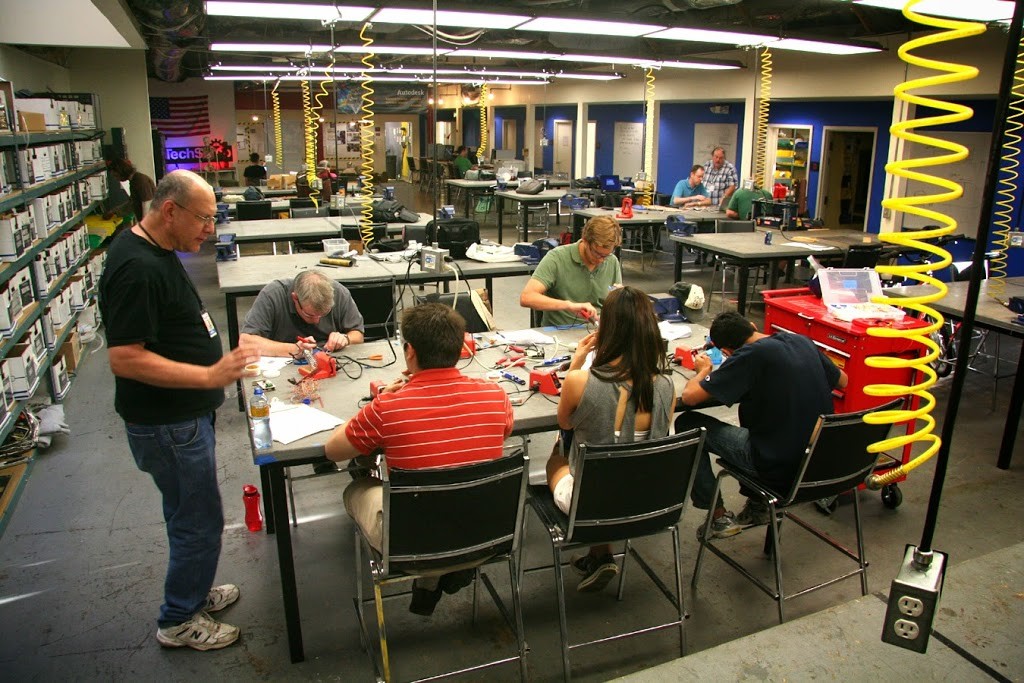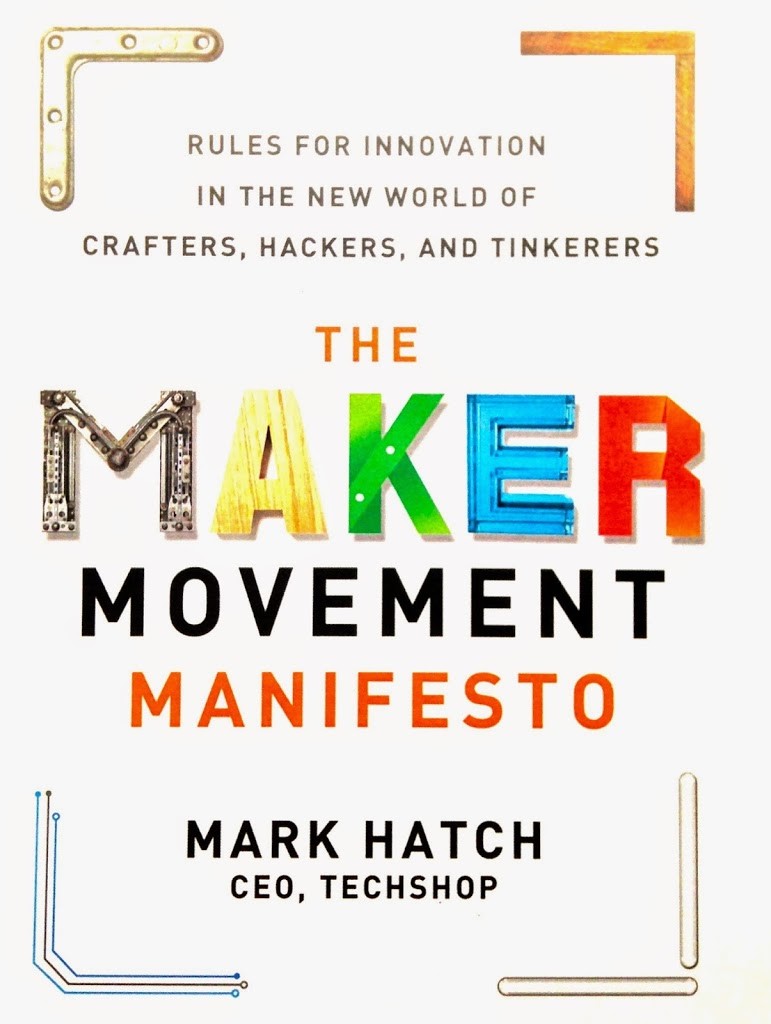
Classes at TechShop’s Menlo Park Premises (courtesy of The passionate maker)
Can you imagine a future where you can design and fabricate your own vehicle? Or perhaps create a custom-built gadget to solve the prevailing haze problem?
Well, apparently you now can. At least in certain parts of the world.
A new revolution in invention is upon us. One focused on creating, building and making physical goods and machines in the real world, aided by advances in technology.
The Maker Movement Manifesto
Named the “Maker Movement”, it arose from the growing numbers of crafters, hackers and tinkerers. By marrying art, science and technology, these 21st century inventors create all manner of goods, toys, machines and tools.
Aided by the “consumerisation” of advanced tools like laser cutters, milling machines, lathes, 3D printers, and AutoCAD software, the rise of the “maker’s economy” is comprehensive documented in The Maker Movement Manifesto by Mark Hatch.
CEO of TechShop, Mark is an early pioneer in the maker’s economy. His company TechShop runs creative spaces that are “part fabrication and prototyping studio, part hackerspace and part learning centre”.
A passionate evangelist for the maker movement, Mark created a manifesto for makers defined by nine theses.
These are summarised below:
- Make – Making is fundamental to what it means to be human. We must make, create, and express ourselves to feel whole, and the things we make are like little pieces of ourselves.
- Share – Sharing what you made and know about making helps you feel whole.
- Give – Few things are more selfless and satisfying than giving away something that you have made. Often these things are the most cherished possessions.
- Learn – You must learn to make, seek to learn about your making, and embrace lifelong learning.
- Tool Up – You must have access to the right tools. Many of these tools are cheaper, easier to use or more powerful than ever before.
- Play – Be playful with what you are making, and you will be surprised, excited and proud of what you discover.
- Participate – Reach out to those around you who are discovering the joy of making. Hold seminars and events (eg Maker Faires) with and for other makers in your community.
- Support – Emotional, intellectual, financial, political and institutional support are needed. With their support, we can improve the world and make a better future.
- Change – Embrace the change that will occur in your maker journey, and become a more complete version of what it means to be human.
Catalysing Creativity and Democratising Innovation
Through narrating anecdotes of inventors whom he met at TechShop, Mark revealed how innovation is democratised and jump-started. By granting easy access, “maker spaces” have made previously capital and knowledge-intensive tools readily available to amateur makers and inventors alike.
Accelerated by the open innovation movement, designs for craft work, machines and tools are now readily downloaded from many online “commons”. Many of them are available either for free or a small fee.
Labelled as the “open source hardware” effort, the rise in cheaper, more powerful and easier to use tools and materials have shortened the innovation curve for makers.
It has also allowed inventors and entrepreneurs to “fail fast”. By doing so, they can learn quickly and move on to their next projects, reducing the costs of failure and encouraging “creative destruction”.
Communities of Making, Funding and Learning
Professional amateurs (pro-ams) are now collaborating and sharing like never before.
Through co-working spaces, start-up accelerators, and crowdfunding platforms like Kickstarter and Indiegogo, wannabe entrepreneurs can shorten their learning curves, form strategic alliances, and benefit from the mentorship and experience of others.
Materials and goods can be easily sourced through platforms like Alibaba. Physical creative clusters can also be formed, for example The HUB and SFMade.
Espousing the virtues of practical, hands-on learning, Mark proposes that traditional barriers to knowledge, learning, control and intelligence are demolished through the open source movement and transparency of information on the Internet. Online institutions like the Khan Academy and Instructables have also made it easier to learn anywhere anytime.
Last but certainly not least, Computer Numerically Controlled (CNC) milling machines, 3D printers, and easier-to-use software (like Autodesk 123 D Make) have made it a lot easier to design and make anything. This ushers in what Mark calls a “personal industrial revolution”.
The Future of Creative Industries
Towards the end of the book, Mark forecasts that the ready access to tools could drive the development of entirely new communities.
Schools, start-ups, artists, researchers and producers would co-evolve in this “third industrial revolution”. Also labelled as “hardware 2.0”, its counterparts are the mobile, social and gaming incubators across the world.
By providing flexible manufacturing capabilities, makerspaces revolutionise the way things are “created, developed, made, financed, sold, and even consumed”. A case in point is FedEx Kinko’s – a place stuffed with 3D printers, mills, lathes, robots, laser cutters and trained folks.
Pet Warmers and Peace Makers
Let me end by sharing the story of Tim Jahingen, one of the entrepreneurs Mark met at TechShop.
Tim worked on an unusual infrared pet-warming device. The gadget consisted of two big panels with coils to produce infrared heat rays to warm an animal as it came out of surgery.
Unfortunately for Tim, a prototype and design shop he approached wanted US$100,000 to do a prototype.
As Tim didn’t have the money, he went to TechShop. There, he did it for only a fraction of the cost. No VC funds, bank loans, or second mortgages on his home was needed. Thanks to his experience at the makerspace, his prototype became so successful that it was eventually in use around the world.
Spurred by his success, Tim went on to invent a cheap to make soccer ball. The idea here was to give the ball to children in conflict zones so that they can play “the beautiful game” together. By doing so, they can straddle political, social and ethnic divides while nurturing peace.
Today, Tim’s One World Futbol Project has distributed over 1.5 million soccer balls around the world.
An Exciting Future for DIY Gadget Geeks
As a content marketer with a deep interest in the creative industries, I found the book a fascinating read. While Singapore may not have the equivalent of makerspaces like the consumer-friendly workshops in the US, we certainly have our fair share of co-working and hacker spaces where inventors and creative entrepreneurs gather.
What are your views on the maker movement? Do you think that such a movement would work around the world?

